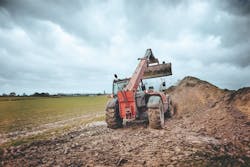Demand for a new off-the-road tire size is contributing to the growth of the market for small OTR tires, which Modern Tire Dealer defines as tires on 25- inch and smaller rims.
BKT USA Inc. places the small and medium OTR market in the U.S. at 60% to 70% of the total off-the-road tire market, with the small OTR market being 20-inch to 25-inch diameter tires and the medium OTR market being 29-inch to 45-inch diameter tires. The company estimates the total OTR market to be between $ 1.6 billion and $ 1.8 billion. The small and medium OTR market is about $1 billion.
“We have started producing and selling OTR tires in last three years and are continually adding sizes every quarter. We expect to have 8% to 10% of available OTR market that we play in,” says Minoo Mehta, BKT’s president.
Worldwide, the off-road tire and track market, which includes all off-road sizes and styles, is $22 billion, or 11% of the entire global tire market, according to Camso Inc. Michael Dembe, executive director of product management for the construction business unit, notes the highly fragmented global market includes tires for construction, agriculture, material handling and powersports equipment.
The global economic recovery is responsible for the overall growth of the market over the last 18 months, according to T. Shawn Rasey, director of global business development of earthmover tires for Continental AG.
“Over the past year, the U.S. market is probably up by at least 10% year-over-year. At Continental, our earthmover tire business is up several multiples of that from last year,” says Rasey.
Continental, like many manufacturers, divides OTR products by usage, rather than size. Products that fall into the 25-inch and under rim size include tires for skid steers, graders, loaders, backhoes, forklifts, and small earthmovers such as articulated dump trucks and bulldozers. Continental also manufactures tires that meet measure 25 inches and under for drill rigs, scaling rigs, bolting drill rigs and for shuttle cars, scoops and face haulers used in underground soft rock applications like coal mines.
Modern Tire Dealer asked manufacturers about the trends in small OTR tire sizes (875/65R29 is gaining in popularity) as well as broader trends in the market.In addition to Mehta from BKT, Dembe from Camso and Rasey from Continental, five other tire makers responded. They are: Seth Walters, vice president- aftermarket sales (East) for Alliance Tire Americas Inc.; Eric Matson, global field engineering manager, Goodyear Tire & Rubber Co.; Justin Brock, marketing manager for construction, Michelin North America Inc.; Bill Dashiell, senior vice president-commercial tire division, TBC Brands LLC; and Bruce Besancon, vice president of OTR sales for Yokohama Tire Corp.
MTD’s first question regarded trends with tire sizes in the small OTR segment. Are any sizes gaining or losing popularity, and if so, what is the cause?
BKT: For the most part, they are still the same sizes that are in use. OE has started using 65 series tires and will create a new replacement size demand. More technologically advanced compounding improving on cut resistance and heat resistance have been introduced. The 65 series is released and in a big way. The equipment manufacturers are using this size for more stability. The dealers and OE are having problems finding some sizes because of demands and availability as to which tire manufactures are making them. The demand on the 875/65R29 is huge and no one has them. BKT now has these tires and has more sizes coming.
Camso: Trends in tire sizes depend on the equipment and machine. If we take telescopic handlers for instance, we see more low profile tires. These are lower aspect ratio tires with larger wheels, meaning less sidewall thickness and reduced cavity for urethane filling for improved stability and reduced cost.
In compact construction some sizes reappear on different machines. For instance, some skid steer tires can go on the front axle of a backhoe loader. Original equipment manufacturers are adopting and adapting common tire sizes to fit different machines. The same tire sizes can fit on different compact construction equipment. For instance, multipurpose or MPT tires (which are more popular in Europe) refer to a range of compact construction equipment using mostly the same tires but handling a range of different jobs: agriculture, road building, residential and commercial construction, scrap yards, landscaping, snow removal and more. We’re talking about compact telehandlers, compact wheel loaders and mini-dumpers, backhoe loaders, concrete truck mixers and rough terrain forklifts.
Just because a tire size fits the machine doesn’t necessarily mean it’s the right tire for the application. To ensure optimal machine performance and lowest operating cost, you need a tire especially designed for the application and for that, you need to look at the tread pattern and technology, too.Continental: In the earthmoving segment, we’re seeing continued growth in demand for 25-inch radials, but there is a move toward lower profile, wide-base sizes such as 65 series tires. In 65 series tires, the aspect ratio of sidewall height to tire section width is 65%. In addition, there is a trend toward more specialized types of 25-inch tires, such as L4, L5 designation products and even “all-season” or “snow tread” OTR tires which fit specific product niches.
Goodyear: The machines that use small OTR tires are getting heavier and more powerful. As a result, small OTR sizes have been trending upward. However, the size of rims and the dimensions of wheel wells can impose limits to tire size. (For example, a machine that rolls off the assembly line sporting 25-inch tires will typically only use 25-inch replacement tires.) Recognizing this dynamic, we’ve increased the strength of our tires’ casing, bead and plies, so our small OTR tires can accommodate heavier loads while working within the same dimensional parameters.
Michelin: The trend in tire sizes depends on the specific machine or application. The tire segment is evolving with several different solutions to meet the various demands of this segment. Radial tires continue to grow, airless options continue to evolve and track machines are also becoming widely accepted for some uses. The tread designs also continue to evolve from the standard R-4.
TBC: Some sizes with growth include the 14.00R24 (G-2), 17.5R25 (E-3/L-3), 20.5R25 (E-3/L-3) and 23.5R25 (E-3/L-3). High volume bias sizes are 12-16.5 (SS-1), 10-16.5 (SS-1), 27x8.50-15 (SS-1), 7.00-12 (IND-1). Positive trends in the above sizes are due to the growth of U.S. total construction, up 4.5% in May 2018 versus May 2017. All other sizes in the small OTR segment remain steady, and we do not see any particular size losing ground to note.
Yokohama: There are some trends that appear to be generic to the overall OTR business, such as the fact that the newer machines being produced in this market segment are tending to be much more environmentally friendly as well as ergonomically designed for employee comfort. We are also typically seeing that the machines entering the market are have higher horsepower than previous models as well as increased weights.
Because of higher horsepower machines, there is some trending to see “larger” tires becoming more standard on some machines, i.e., seeing more 17.5R25 tires than 14.00R24 than in the past and new dimensions becoming more popular on some loader models such as the 875/65R29 vs 29.5R25; this allows higher carrying capacity as well as some stability enhancements for the machine.
A LOOK AT THE OVERALL MARKET
Modern Tire Dealer also asked manufacturers for their perspective on overall market trends for small OTR tires.
Alliance: The biggest market trend in small OTR is radialization. Small OTR has been the slowest segment of OTR tires to convert to radials, and even today the figure is less than half - around 45% radial. That leaves a lot of room for growth, especially as the radial options become better and more competitive than ever.
BKT: We have seen heavier star ratings, up to four stars, and a few new, more effective tread designs have been introduced.
Camso: Construction equipment users are increasingly adopting tracks over tires and, along the way, boosting machine performance and productivity. Industry studies in recent years reported that unit sales of compact track loaders are actually outpacing the sale of the traditional skid steers. This includes in the rental, construction and agricultural sectors long considered the cradle markets for skid steers. There is a trend toward tracked construction equipment which provide increased traction, floatation, stability and durability over wheeled equipment.With an increased dependency on rental companies to cost-effectively provide a greater variety of equipment types to customers who will work the equipment liberally and often aggressively, having tires that avoid flats is key. That’s where solid tire come into play. Solid tire have been popular for skid steer loaders used in puncture-prone and severe or environmentally challenging applications for years, but thanks to newer options, solid tires are now viable for telescopic handlers, compact wheel loaders and even full-sized wheel loaders. With the price now similar to that of foam-filled tires, the rental market is leading the shift to solid tires.
With the larger and faster machines often “roading” between job sites or operating at higher speeds, radial tires are increasingly popular for bigger machines.
Continental: Like most things in our society today, technology and information management is quickly becoming a must-do for most end user customers. One good example is our ContiPressureCheck that comes as standard fitment in all of our radial tires. ContiPressureCheck measures both heat and air pressure, which translates into better fleet operations. For OTR tires, this means optimal air pressure maintenance and catching small problems before they manifest into bigger issues. The number one thing that a customer can do to improve tire life, handling and overall safety is to maintain recommended air pressures.Another trend is the creation of specialized tires for specific applications. Many companies are still producing “one-size-fits-all” tires, but Continental is proving that specialized tires outperform the best of the competition on key factors driven by application-specific requirements such as speed, distance, weight, temperature, humidity, surface conditions and many other factors.
Michelin: Snow tires, hard surface tires, tires for severe off-road and multi-purpose tires are in demand via customer requests. Many end users use the same tire all year round, so they want a tire that will perform in all conditions and seasons. Owners want trucks to carry more, carry it faster and experience little or no downtime. As machines evolve, the tires are expected to perform and carry more load, increase productivity, increase uptime and provide customer satisfaction to get the job done.
While there are innovations happening in the industrial market, the primary needs of the consumer remain the same: productivity, minimum downtime, low cost per hour, stability, safety and comfort. Today’s industrial machines are capable of more power, torque, and load capacity than ever before. Reduction in machine downtime is a huge factor to the industrial market, because a machine not working is not generating any revenue.
TBC: According to the U.S. Census Bureau, U.S. total construction is up 4.5% versus the same period last year as of May 2018. The adjusted annual U.S. construction spending forecast is now at an all-time high of $1.3 trillion. Some of the highlights of the growth are private and public construction projects, investment in residential projects and spending on new single-family homes. This additional construction spending trend equates to direct increase of small OTR equipment usage. Even with this increased construction spending we see end users looking for quality and value.
Yokohama: Tires are being designed with newer and more ecologically sound materials — and there is a significant emphasis to continue bettering the tire performance with each iteration of design. As uses for machines become more “niche” for specific markets there is an enhanced need for more application-specific designed tires – meaning there are more tread compounds/dimensions/tread patterns than we have ever seen before — all leading to higher productivity for the end customer. ?




